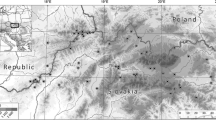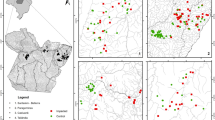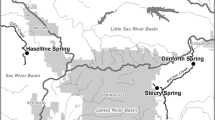Abstract
Habitat specialists and generalists are known to differ in their width of environmental tolerance and their representation can vary along with the ecological contrast of habitats. In this study we explore factors shaping patterns of species richness and abundance of aquatic macroinvertebrate habitat specialists and generalists at isolated spring fens, separately for spring patch and spring brook mesohabitats at each site. We also examined habitat contrast of these unique island-like communities by the comparison of spring fen specialists and habitat generalists shared between the two spring fen mesohabitats and the nearest stream to each of 13 selects fen sites. Aquatic macroinvertebrates (Clitellata, Ephemeroptera, Plecoptera, Trichoptera, and Diptera) were investigated at 62 isolated spring fens, with 357 taxa identified in more than 172,000 individuals collected. We found that specialists experienced a stronger relation to local environmental conditions (i.e. the amount of dissolved oxygen and water conductivity) at both spring mesohabitats than generalists, primarily responding to fen habitat size. In contrast, responses of species abundances at spring patches and spring brooks differed as the abundances were controlled by the amount of oxygen in spring patches and by habitat size in spring brooks. Based on Trichoptera and Diptera assemblages we found a similar contrast between both spring fen sites and nearby streams. Our results suggest a higher resilience of specialist populations in well oxygenated sites and their competitive advantage over generalists at these sites, which stresses the importance to prevent any significant decrease of oxygenation (e.g., by eutrophication or drainage), especially in spring patches.
Similar content being viewed by others
References
Anderson M.J. 2001. A new method for non-parametric multivariate analysis of variance. Austral. Ecol. 26 1: 32–46. DOI: https://doi.org/10.1111/j.1442-9993.2001.01070.pp.x
Anderson M.J. 2006. Distance-based tests for homogeneity of multivariate dispersions. Biometrics 62 1: 245–253. DOI: https://doi.org/10.1111/j.1541-0420.2005.00440.x
Bender D.J. & Fahrig L. 2005. Matrix structure obscures the relationship between interpatch movement and patch size and isolation. Ecology 86 4: 1023–1033. DOI: https://doi.org/10.1890/03-0769686
Bezděk A., Jaroš J. & Spitzer K. 2006. Spatial distribution of ground beetles (Coleoptera: Carabidae) and moths (Lepidoptera) in the Mrtvý luh bog, Šumava Mts (Central Europe): a test of habitat island community. Biodivers. Conserv. 15 1: 395–409. DOI: https://doi.org/10.1007/s10531-005-3435-z
Bojková J., Schenková J., Horsák M. & Hájek M. 2011. Species richness and composition patterns of clitellate (Annelida) assemblages in the treeless spring fens: the effect of water chemistry and substrate. Hydrobiologia 667 1: 159–171. DOI: https://doi.org/10.1007/s10750-011-0634-3
Brändle M., Westermann I. & Brandl R. 2005. Gene flow between populations of two invertebrates in springs. Freshwater Biol. 50 1: 1–9. DOI: https://doi.org/10.1111/j.1365-2427.2004.01288.x
Brouat C., Chevallier H., Meusnier S., Noblecourt T. & Rasplus J.Y. 2004. Specialization and habitat: spatial and environmental effects on abundance and genetic diversity of forest generalist and specialist Carabus species. Mol. Ecol. 13 7: 1815–1826. DOI: https://doi.org/10.1111/j.1365-294X.2004.02206.x
Buffagni A., Cazzola M., López-Rodríguez M.J., Alba-Tercedor J. & Armanini D.G. 2009. Distribution and Ecological Preferences of European Freshwater Organisms. Volume 3, Ephemeroptera. Pensoft, Sofia-Moscow, 254 pp. ISBN-13: 9789546425089
Cantonati M., Gerecke R. & Bertuzzi E. 2006. Springs of the Alps-sensitive ecosystems to environmental change: from biodiversity assessments to long-term studies. Hydrobiologia 562 1: 59–96. DOI: https://doi.org/10.1007/s10750-005-1806-9
Carl P. & Peterson B.G. 2010. PerformanceAnalytics: Econometric Tools for Performance and Risk Analysis. R Package, version 1.0.2.1. https://doi.org/braverock.com/R/
Chislock M.F., Doster E., Zitomer R.A. & Wilson A.E. 2013. Eutrophication: causes, consequences, and controls in aquatic ecosystems. Nature Education Knowledge 4 4: 10.
Collinge S.K. & Palmer T.M. 2002. The influences of patch shape and boundary contrast on insect response to fragmentation in California grasslands. Landscape Ecol. 17 7: 647–656. DOI: https://doi.org/10.1023/A:1021536302195
Cook R.D. 1977. Detection of influential observation in linear regression. Technometrics 19 1: 15–18. DOI: https://doi.org/10.2307/1268249
Devictor V., Clavel J., Julliard R., Lavergne S., Mouillot D., Thuiller W., Venail P., Villéger S. & Mouquet N. 2010. Defining and measuring ecological specialization. J. Appl. Ecol. 47 1: 15–25. DOI: https://doi.org/10.1111/j.1365-2664.2009.01744.x
Devictor V., Julliard R. & Jiguet F. 2008. Distribution of specialist and generalist species along spatial gradients of habitat disturbance and fragmentation. Oikos 117 4: 507–514. DOI: https://doi.org/10.1111/j.0030-1299.2008.16215.x
Dyer L.A., Singer M.S., Lill J.T., Stireman J.O., Gentry G.L., Marquis R.J., Ricklefs R.E., Greeney H.F., Wagner D.L., Morais H.C., Diniz I.R., Kursar T.A. & Coley P.D. 2007. Host specificity of Lepidoptera in tropical and temperate forests. Nature 448 7154: 696–699. DOI: https://doi.org/10.1038/nature05884
ESRI 2003. Arcview GIS, version 8. 3. Environmental Systems Research Institute Inc., Redlands. https://doi.org/www.esri.com
Ferry-Graham L.A., Bolnick D.I. & Wainwright P.C. 2002. Using functional morphology to examine the ecology and evolution of specialization. Integr. Comp. Biol. 42 2: 265–277. DOI: https://doi.org/10.1093/icb/42.2.265.
Funk A., Schiemer F. & Reckendorfer W. 2013. Metacommunity structure of aquatic gastropods in a river floodplain: the role of niche breadth and drift propensity. Freshwater Biol. 58 12: 2505–2516. DOI: https://doi.org/10.1111/fwb.12228
Futuyma D.J. & Moreno G. 1988. The evolution of ecological specialization. Annu. Rev. Ecol. Syst. 19: 207–233. DOI: https://doi.org/10.1146/annurev.es.19.110188.001231
Graf W., Lorenz A.W., Tierno de Figueroa J.M., Lucke S., Lopez-Rodriguez M.J. & Davies C. 2009. Distribution and Ecological Preferences of European Freshwater Organisms. Volume 2, Plecoptera. Pensoft, Sofia-Moscow, 262 pp. ISBN-13: 9789546424792
Graf W., Murphy J., Dahl J., Zamora-Mu´noz C. & López- Rodríguez M.J. 2008. Distribution and Ecological Preferences of European Freshwater Organisms. Volume 1, Trichoptera. Pensoft, Sofia-Moscow, 388 pp. ISBN-13: 9789546424419
Hájek M., Horsák M., Hájková P. & Dítě D. 2006. Habitat diversity of central European fens in relation to environmental gradients and an effort to standardise fen terminology in ecological studies. Perspect. Plant Ecol. Evol. Syst. 8 2: 97–114. DOI: https://doi.org/10.1016/j.ppees.2006.08.002
Hájek M., Horsák M., Tichý L., Hájková P. & Dítě D. & Jamrichová E. 2011. Testing a relict distributional pattern of fen plant and terrestrial snail species at the Holocene scale: a null model approach. J. Biogeogr. 38 4: 742–755. DOI: https://doi.org/10.1111/j.1365-2699.2010.02424.x
Hájková P., Wolf P. & Hájek M. 2004. Environmental factors and Carpathian spring fen vegetation: the importance of scale and temporal variation. Ann. Bot. Fennici 41: 249–262.
Horsák M. 2006. Mollusc community patterns and species response curves along a mineral richness gradient: a case study in fens. J. Biogeogr. 33 1: 98–107. DOI: https://doi.org/10.1111/j.1365-2699.2005.01359.x
Horsák M., Hájek M., Spitale D., Hájková P., Dítě D. & Nekola J.C. 2012. The age of island-like habitats impacts habitat specialist species richness. Ecology 93 5: 1106–1114. DOI: https://doi.org/10.1890/0012-9658-93.5.1106
Horsák M., Rádková V., Syrovátka V., Bojková J., Kroupalová V., Schenková J. & Zajacová J. 2015. Drivers of aquatic macroinvertebrate richness in spring fens in relation to habitat specialization and dispersal mode. J. Biogeogr. 42 11: 2112–2121. DOI: https://doi.org/10.1111/jbi.12569
Hubbs C. 1995. Perspectives: springs and spring runs as unique aquatic systems. Copeia 1995 4: 989–991. DOI: https://doi.org/10.2307/1447053
Joosten H. & Clarke D. 2002. Wise use of mires and peatlands: background and principles including a framework for decision making. International Mire Conservation Group and International Peat Society, Saarijärvi, Finland, 303 pp. ISBN: 951-97744-8-3
Kolasa J. & Li B.L. 2003. Removing the confounding effect of habitat specialization reveals the stabilizing contribution of diversity to species variability. Proc. Roy. Soc. B — Biol. Sci. 270 (Suppl. 2): S198–S201. DOI: https://doi.org/10.1098/rsbl.2003.0059
Kroupalová V., Opravilová V., Bojková J. & Horsák M. 2013. Diversity and assemblage patterns of microorganisms structured by the groundwater chemistry gradient in spring fens. Ann. Limnol. — Int. J. Lim. 49 2013: 207–223. DOI: https://doi.org/10.1051/limn/2013056
Leibold M.A., Holyoak M., Mouquet N., Amarasekare P., Chase J.M., Hoopes M.F., Holt R.D., Shurin J.B., Law R., Tilman D., Loreau M. & Gonzalez A. 2004. The metacommunity concept: a framework for multi-scale community ecology. Ecol. Lett. 7 7: 601–613. DOI: https://doi.org/10.1111/j.1461-0248.2004.00608.x
Lövei G.L., Magura T., Tóthmérész B. & Ködöböcz V. 2006. The influence of matrix and edges on species richness patterns of ground beetles (Coleoptera: Carabidae) in habitat islands. Global Ecol. Biogeogr. 15 3: 283–289. DOI: https://doi.org/10.1111/j.1466-8238.2005.00221.x
MacArthur R.H. & Wilson E.O. 1967. The Theory of Island Biogeography. Princeton Landmarks in Biology Series. Princeton Univ Press, Princeton, 203 pp. ISBN: 0691088365, 9780691088365
McCabe D.J. 1998. Biological communities in springbrooks, pp. 221–228. In: Botosaneanu L. (ed), Studies in Crenobiology: The Biology of Springs and Springbrooks, Backhuys, Leiden, 261 pp. ISBN: 90-73348-04-8
Oksanen J., Blanchet F.G., Kindt R., Legendre P., Minchin P.R., O’Hara R.B., Simpson G.L., Solymos P., Stevens M.H.H. & Wagner H. 2013. Vegan: Community ecology package, R package version 2.0-7.
Omelková M., Syrovátka V., Kroupalová V., Rádková V., Bojková J., Horsák M., Zhai M. & Helešic J. 2013. Dipteran assemblages of spring fens closely follow the gradient of groundwater mineral richness. Can. J. Fish. Aquat. Sci. 70 5: 689–700. DOI: https://doi.org/10.1139/cjfas-2013-0026
Pandit S.N., Kolasa J. & Cottenie K. 2009. Contrasts between habitat generalists and specialists: an empirical extension to the basic metacommunity framework. Ecology 90 8: 2253–2262. DOI: https://doi.org/10.1890/08-0851.1
Prevedello J.A. & Vieira M.V. 2010. Does the type of matrix matter? A quantitative review of the evidence. Biodivers. Conserv. 19 5: 1205–1223. DOI: https://doi.org/10.1007/s10531-009-9750-z
R Core Team 2014. R: A language and environment for statistical computing. R Foundation for Statistical Computing, 2013, Vienna. Austria. https://doi.org/www.R-project.org
Rádková V., Bojková J., Kroupalová V., Schenková J., Syrovátka V. & Horsák M. 2014a. The role of dispersal mode and habitat specialisation in metacommunity structuring of aquatic macroinvertebrates in isolated spring fens. Freshwater Biol. 59 11: 2256–2267. DOI: https://doi.org/10.1111/fwb.12428
Rádková V., Syrovátka V., Bojková J., Schenková J., Kroupalová V. & Horsák M. 2014b. The importance of species replacement and richness differences in small-scale diversity patterns of aquatic macroinvertebrates in spring fens. Limnologica 47: 52–61. DOI: https://doi.org/10.1016/j.limno.2014.03.001
Ricketts T.H. 2001. The matrix matters: effective isolation in fragmented landscapes. Am. Nat. 158 1: 87–99. DOI: https://doi.org/10.1086/320863
Ricklefs R.E. 1987. Community diversity: relative roles of local and regional processes. Science 235 4785: 167–171. DOI: https://doi.org/10.1126/science.235.4785.167
Rozkošný R. & Kniepert F.W. 2000. Insecta: Diptera: Stratiomyidae, Tabanidae. Series: Süsswasserfauna von Mitteleuropa 21 (18-19), Spektrum Akademischer Verlag Heidelberg, Berlin, 204 pp. ISBN: 3827409861, 9783827409867
Smith H., Wood P.J. & Gunn J. 2003. The influence of habitat structure and flow permanence on invertebrate communities in karst spring systems. Hydrobiologia 510 1: 53–66. DOI: https://doi.org/10.1023/B:HYDR.0000008501.55798.20
Spitze, K. & Sadler, T.D. 1996. Evolution of a generalist genotype: multivariate analysis of the adaptiveness of phenotypic plasticity. Am. Nat. 148 (Suppl.): S108–S123.
Šporka F. 2003. Vodné bezstavovce (makroevertebrata) Slovenska, súpis druhov a autekologické charakteristiky [Slovak aquatic macroinvertebrates, checklist and catalogue of autecological notes]. Slovenský hydrometeorologický ústav, Bratislava, 590 pp. ISBN: 80-88907-37-3
Van der Kamp G. 1995. The hydrogeology of springs in relation to the biodiversity of spring fauna: a review. J. Kans. Entomol. Soc. 68 (2 Suppl.): 4–17.
Wagner R., Fisher J. & Schnabel S. 1998. The Dipteran community of Central European springs, a summary, pp. 157–165. In: Botosaneanu L. (ed.), Studies in Crenobiology: The Biology of Springs and Springbrooks, Backhuys, Leiden, 261 pp. ISBN-10: 90-73348-0-48, ISBN-13: 978-90-73348-0-42
Watson D.M. 2002. A conceptual framework for studying species composition in fragments, islands and other patchy ecosystems. J. Biogeogr. 29 5: 823–834. DOI: https://doi.org/10.1046/j.1365-2699.2002.00726.x
Wilk M.B. & Gnanadesikan R. 1968. Probability plotting methods for the analysis of data. Biometrika 55 1: 1–17. DOI: https://doi.org/10.1093/biomet/55.1.1
Williams D.D. & Williams N.E. 1999. Canadian Springs: postglacial development of the invertebrate fauna, pp. 447–467. In: Batzer D.P., Rader R. & Wissinger A. (eds), Invertebrates in Freshwater Wetlands of North America: Ecology and Management, John Wiley and Sons, New York, 1120 pp. ISBN: 0471292583, 978-0-471-29258-6
Zhai M., Nováček O., Výravský D., Syrovátka V., Bojková J. & Helešic J. 2015. Environmental and spatial control of ostracod assemblages in the Western Carpathian spring fens. Hydrobiologia 745 1: 225–239. DOI: https://doi.org/10.1007/s10750-014-2104-1
Author information
Authors and Affiliations
Corresponding author
Rights and permissions
About this article
Cite this article
Hubáčková, L., Rádková, V., Bojková, J. et al. Diversity patterns of aquatic specialists and generalists: contrasts among two spring-fen mesohabitats and nearby streams. Biologia 71, 678–687 (2016). https://doi.org/10.1515/biolog-2016-0084
Received:
Accepted:
Published:
Issue Date:
DOI: https://doi.org/10.1515/biolog-2016-0084




